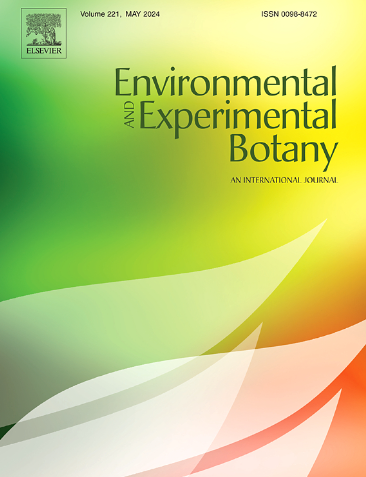生物炭通过调控脱落酸信号和光合作用,提高了部分根区干燥灌溉条件下紫花苜蓿水分利用效率
IF 4.7
2区 生物学
Q2 ENVIRONMENTAL SCIENCES
引用次数: 0
摘要
亏缺灌溉可能通过调节气孔形态和光合生理来提高植物水分利用效率,而在盐渍化土壤中,生物炭改性和亏缺灌溉对紫花苜蓿生长和叶片生理的综合影响尚不清楚。采用裂根盆栽试验,研究了不同生物炭改型(WSB:小麦秸秆生物炭;CSB:玉米秸秆生物炭)和不同灌溉方式(FI:全灌;DI:亏缺灌,70% %全根区灌;PRDI:部分根区干灌,只灌一半根区,土壤含水量保持与直灌相同水平)对紫花苜蓿叶片形态生理性状和水分利用效率的影响。DI和PRDI表现出类似的趋势,均通过改变气孔特征和提高叶片脱落酸浓度([ABA]叶片)而显著降低气孔导度(gs)、碳同位素辨别(Δ13Cleaf)和净CO2同化率(a),从而降低生物量积累。与此相反,生物炭添加WSB和CSB显著改善了土壤持水能力、根系吸水性和叶片水分状况,降低了[ABA]叶片,增加了气孔密度(SD)、气孔大小(SS)和Δ13Cleaf。值得注意的是,PRDI联合生物炭改性显著提高了叶片的内在水分利用效率(A/gs)和长期水分利用效率(以较低的Δ13Cleaf表示),从而使植物规模的水分利用效率(WUEplant)比未经PRDI改性的植物提高了39-56 %。综上所述,在盐渍化土壤中,生物炭改进剂和亏缺灌溉的联合施用有助于提高紫花苜蓿的管理效率和生态可持续性。未来的研究应该调查长期影响、潜在机制和在不同环境背景下的大规模适用性。本文章由计算机程序翻译,如有差异,请以英文原文为准。
Biochar amendment enhances water use efficiency in alfalfa (Medicago sativa L.) under partial root-zone drying irrigation by modulating abscisic acid signaling and photosynthetic performance
Deficit irrigation can potentially increase plant water use efficiency by regulating stomatal morphology and photosynthetic physiology, whereas the combined effects of biochar amendment and deficit irrigation on alfalfa growth and leaf physiology remain largely unknown in salt-affected soil. A split-root pot experiment was implemented to investigate the effect of biochar amendments (WSB: wheat straw biochar; CSB: corn straw biochar) and irrigation regimes (FI: full irrigation; DI: deficit irrigation, 70 % of FI on the entire root zone; PRDI: partial root-zone drying irrigation, only irrigating half of the root zone with soil water content maintained at the same level as that under DI) on the leaf morpho-physiological traits and water use efficiency of alfalfa (Medicago sativa L.). DI and PRDI exhibited a similar trend, with both leading to a significant reduction in stomatal conductance (gs), carbon isotope discrimination (Δ13Cleaf), and net CO2 assimilation rate (A) by altering stomatal traits and elevating leaf abscisic acid concentration ([ABA]leaf), resulting in lower biomass accumulation. In contrast, biochar amendment of WSB and CSB significantly improved soil water-holding capacity, root water uptake and leaf water status, resulting in lower [ABA]leaf and enhanced stomatal density (SD), stomatal size (SS) and Δ13Cleaf. Notably, PRDI combined with biochar amendment substantially enhanced leaf intrinsic WUE (A/gs) and long-term WUE indicated by lower Δ13Cleaf, thereby increasing plant-scale WUE (WUEplant) by 39–56 % compared to non-biochar-amended under PRDI treatment. Overall, co-application of biochar amendment and deficit irrigation facilitates more efficient and ecologically sustainable alfalfa management in salt-affected soil. Future studies should investigate long-term effects, underlying mechanisms, and large-scale applicability across diverse environmental contexts.
求助全文
通过发布文献求助,成功后即可免费获取论文全文。
去求助
来源期刊

Environmental and Experimental Botany
环境科学-环境科学
CiteScore
9.30
自引率
5.30%
发文量
342
审稿时长
26 days
期刊介绍:
Environmental and Experimental Botany (EEB) publishes research papers on the physical, chemical, biological, molecular mechanisms and processes involved in the responses of plants to their environment.
In addition to research papers, the journal includes review articles. Submission is in agreement with the Editors-in-Chief.
The Journal also publishes special issues which are built by invited guest editors and are related to the main themes of EEB.
The areas covered by the Journal include:
(1) Responses of plants to heavy metals and pollutants
(2) Plant/water interactions (salinity, drought, flooding)
(3) Responses of plants to radiations ranging from UV-B to infrared
(4) Plant/atmosphere relations (ozone, CO2 , temperature)
(5) Global change impacts on plant ecophysiology
(6) Biotic interactions involving environmental factors.
 求助内容:
求助内容: 应助结果提醒方式:
应助结果提醒方式:


